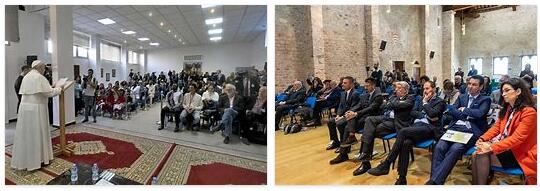Therefore, before embarking on the crusade to which he was obliged, Frederick turned to the north, where he was not lacking partisans and supporters: the Ghibellines. In short, he resumed the policy of Barbarossa of his ancestor and of Henry his father. And like Barbarossa and Enrico, again he found himself facing the Holy See: first Pope Honorius III, then, worse, Gregory IX (1227-41), the old Ugolino cardinal bishop of Ostia, energetic advocate and restorer of ecclesiastical rights , shrewd disciplinary of the Franciscan movement, of such an uncertain nature, in the cadres of the Church and the papacy. Again the resurrected Lombard league faced and armed. Having succeeded in the ban launched against the cities, excommunicated by Gregory, Frederick left for the Holy Land, bought back the holy places for negotiations, there he crowned himself king of Jerusalem (1228-29), he returned to the kingdom where in the meantime the pope had started the crusade against the crusader king and put his country in turmoil, he reconquered it, drove out the papalines, made peace with the pope (San Germano 1230), freed himself from excommunication, after some concessions in terms of the rights of the clerics in the kingdom, he carried out his work of ordering and legislation and gave it the juridical seal in the assisi of Melfi, 1231. Then he returned to the things of the north, trying to maintain good relations with the curia. He took the defense of the pope who was in dispute with the Romans. He persecuted heretics in his kingdom and sought to have antiheretic constitutions observed in the north as well. He also accepted that the pope would become an arbitrator and pronounce an arbitration sentence in the controversy between him and the municipalities of the league. But when his son Henry rebelled against him in Germany in 1235, and the cities took the side of the rebel, then Frederick, having put down the rebellion, moved against the league and declared the pacts of Constance null and void; he rejected Gregory’s mediation, which naturally inclined towards the cities, and defeated the associates at Cortenuova, 1237; he rejected the conditional conciliation that the Lombards offered him; he procured to his son Enzo, through the marriage with Adelasia di Torre, widow of Ubaldo Visconti judge of Gallura, the title of king of Sardinia.
But the first military failures also came in the Po valley, following an offensive resumption of the league; Gregory’s anger exploded over the question of the Sicilian clerics and then of Sardinia over which the Holy See asserted its eminent right; a new excommunication fell on Frederick in 1239. And it was full rupture, war without quarter on both sides. The two contenders were equally led not only to draw partisans to themselves, to materially widen the field of conflict, even between kings and lords and bourgeois beyond the Alps, to propagate their reasons by means of mendicant friars or polemical writings or proclaim; but also to settle on a more secure and higher theoretical basis. Thus Frederick, on his side, worked out and ordered his royal law and the communes their statutes, almost lex now also; and the jurists brought their contribution of Roman law to the royal and imperial and city construction. According to ejinhua.org, the king and emperor tried to elevate himself also religiously and present himself invested with the right to reform the Church, thus lighting up not a few hopes of heretics or sympathizers. On the other hand, the Roman discipline of the new monastic orders was strengthened; the “Guelph party” was increasingly drawn to Rome, until it became the pars ecclesiae ; the persecution of heretics was exacerbated and its organs perfected; the Decretales , commissioned by the pugnacious Gregory IX, took the place of the Decretum, a private compilation of a Bolognese monk, reflecting the highest and most central position that the papacy and curia had acquired in the Church. With Innocent IV (1243-1254), then, the external, human, contingent titles to which the popes had already referred to affirm their political power over this or that province or kingdom were put aside, and this power was affirmed as proper to the Church, by virtue of its divine origin. The spiritual sphere expanded more than ever, absorbing and understanding every relationship of life, subjected entirely to the control of religious power, depositary of the divine, and became a huge annexus of the spiritual. The pope felt more and more authorized to intervene, ratione peccati , in every human event.
